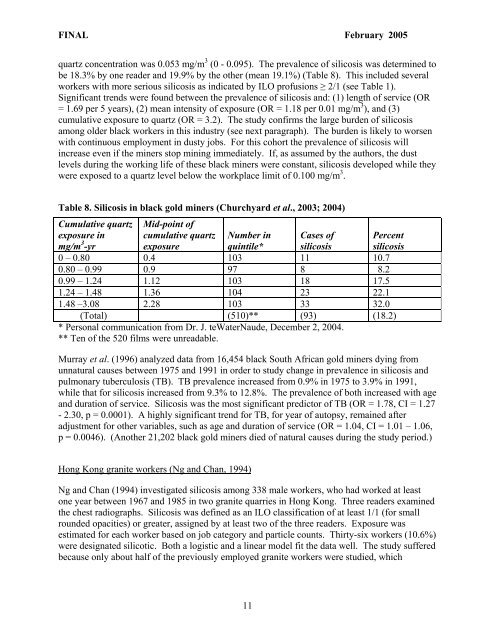Silica (crystalline, respirable) - OEHHA
Silica (crystalline, respirable) - OEHHA
Silica (crystalline, respirable) - OEHHA
You also want an ePaper? Increase the reach of your titles
YUMPU automatically turns print PDFs into web optimized ePapers that Google loves.
FINAL February 2005<br />
quartz concentration was 0.053 mg/m 3 (0 - 0.095). The prevalence of silicosis was determined to<br />
be 18.3% by one reader and 19.9% by the other (mean 19.1%) (Table 8). This included several<br />
workers with more serious silicosis as indicated by ILO profusions ≥ 2/1 (see Table 1).<br />
Significant trends were found between the prevalence of silicosis and: (1) length of service (OR<br />
= 1.69 per 5 years), (2) mean intensity of exposure (OR = 1.18 per 0.01 mg/m 3 ), and (3)<br />
cumulative exposure to quartz (OR = 3.2). The study confirms the large burden of silicosis<br />
among older black workers in this industry (see next paragraph). The burden is likely to worsen<br />
with continuous employment in dusty jobs. For this cohort the prevalence of silicosis will<br />
increase even if the miners stop mining immediately. If, as assumed by the authors, the dust<br />
levels during the working life of these black miners were constant, silicosis developed while they<br />
were exposed to a quartz level below the workplace limit of 0.100 mg/m 3 .<br />
Table 8. Silicosis in black gold miners (Churchyard et al., 2003; 2004)<br />
Cumulative quartz<br />
exposure in<br />
Mid-point of<br />
cumulative quartz<br />
Percent<br />
silicosis<br />
mg/m 3 Number in Cases of<br />
-yr exposure quintile* silicosis<br />
0 – 0.80 0.4 103 11 10.7<br />
0.80 – 0.99 0.9 97 8 8.2<br />
0.99 – 1.24 1.12 103 18 17.5<br />
1.24 – 1.48 1.36 104 23 22.1<br />
1.48 –3.08 2.28 103 33 32.0<br />
(Total) (510)** (93) (18.2)<br />
* Personal communication from Dr. J. teWaterNaude, December 2, 2004.<br />
** Ten of the 520 films were unreadable.<br />
Murray et al. (1996) analyzed data from 16,454 black South African gold miners dying from<br />
unnatural causes between 1975 and 1991 in order to study change in prevalence in silicosis and<br />
pulmonary tuberculosis (TB). TB prevalence increased from 0.9% in 1975 to 3.9% in 1991,<br />
while that for silicosis increased from 9.3% to 12.8%. The prevalence of both increased with age<br />
and duration of service. Silicosis was the most significant predictor of TB (OR = 1.78, CI = 1.27<br />
- 2.30, p = 0.0001). A highly significant trend for TB, for year of autopsy, remained after<br />
adjustment for other variables, such as age and duration of service (OR = 1.04, CI = 1.01 – 1.06,<br />
p = 0.0046). (Another 21,202 black gold miners died of natural causes during the study period.)<br />
Hong Kong granite workers (Ng and Chan, 1994)<br />
Ng and Chan (1994) investigated silicosis among 338 male workers, who had worked at least<br />
one year between 1967 and 1985 in two granite quarries in Hong Kong. Three readers examined<br />
the chest radiographs. Silicosis was defined as an ILO classification of at least 1/1 (for small<br />
rounded opacities) or greater, assigned by at least two of the three readers. Exposure was<br />
estimated for each worker based on job category and particle counts. Thirty-six workers (10.6%)<br />
were designated silicotic. Both a logistic and a linear model fit the data well. The study suffered<br />
because only about half of the previously employed granite workers were studied, which<br />
11















